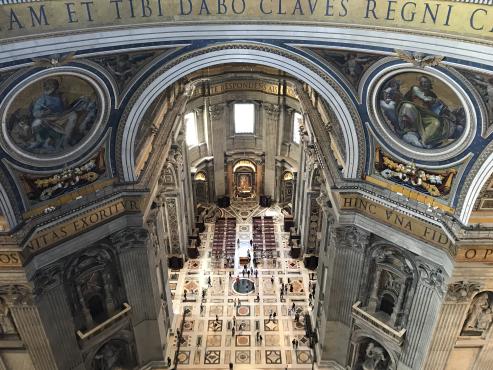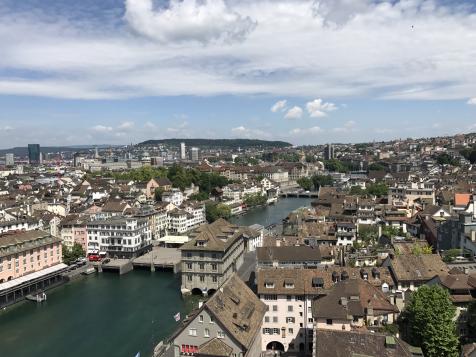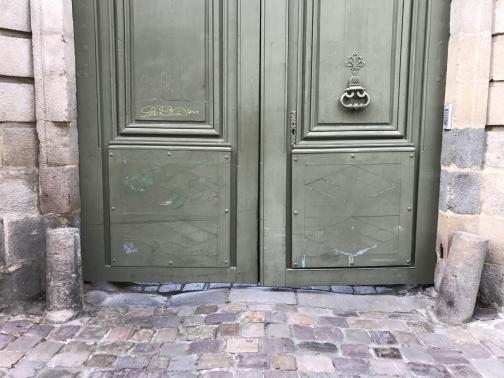pile.org
2017 E5 walk: Epilogue
My phone counted almost 2½ million steps. I averaged more than 42,000 steps per day.1 Most of my “low” days (less than 32,000 steps) were zero-days, or the end of the first week when my ankle was hurting. I climbed or descended more than 8,000 flights’ worth of stairs, which doesn’t even begin to count my actual elevation gain and loss. Converting steps to miles, my phone thought I averaged 16½ miles per day, 972 miles total, which I suspect are underestimates.2
Weather was pretty favorable for me, in general. April was quite dry (around 15–30% of Brittany’s average rainfall), and started warm, though there was a stretch of chilly nights for the last week and a half or so. May’s rainfall was more typical, and the weather was quite warm for the last week.
I camped about half the time, and under a variety of types of roof (gîte, room, hotel, and (twice) an entire tiny flat) the other half. I have no idea how many croissants and assorted pastries I ate (it was a lot), and likewise have no idea how many calories I burned (also a lot).
If I were to do this again — or rather, if I were to walk another section of the E5, since I’d prefer to “complete” it before I rewalk any portion — there are a few things I’d probably do differently.
First, I would spend a significant amount of time getting proficient with the language. With a bit of practice, I believe I can refresh my high school German to get by acceptably. My conversational Italian (a.k.a. “ristorante” — sufficient to order food in a restaurant) is a decent base to grow from. But my French only improved from absolutely nothing to merely terrible; it was arrogant of me to assume I’d be able to pick up the language well enough without any study.
Next, I would try to make sleeping arrangements — campsite, gîte, etc. — in advance. In addition to knowing my average walking range, I also have a sense of how far I can push myself on those days where the only thing available is another three miles farther. I would also have a better understanding of how elevation changes on a map equate to the terrain’s actual hiking difficulty.
I would also make a point to take more pictures. Looking back at the pictures I did take, there was never a day where I wished I hadn’t taken so many. I’m even curious about what it might be like to record video of the walk, which would communicate so much more than words or photos (though I’m skeptical of what the power draw would be — would this make it harder to get from one electrical outlet to the next?).
Finally, and most importantly, I would not plan to be away from my family for two months, to say nothing of the five or so months of the full E5.
I would guesstimate that the next big stretch of the E5, the GR 2 from Paris to near Dijon (a little more than 300 miles), would be perhaps three weeks of walking, similar to the stretch from Mont-Saint-Michel to Paris. (An unofficial site breaks it into four sections, though they’re presented backwards, e.g. Montereau-Fault-Yonne to Paris, instead of Paris to Montereau-Fault-Yonne as I would walk it.)
The next stretch would be from Dijon over the Vosges via the GR 7, perhaps 200 miles and two weeks (possibly longer due to the mountainous terrain). From there the trail goes south to the border with Switzerland, and then (I’m a little less clear on the details of this part) up to Basel. From Basel it follows the Via Rhenana east to Constance, 120 miles and maybe a bit more than a week. The final long stretch, the “classic E5”, would be from Constance to Verona.3 Gillian Price’s Across the Eastern Alps: The E5 (perhaps out of print?) conveniently breaks it down into 29 days, 365 miles.
If I were to do exactly one more long walk along the E5, I would probably attempt the Alpine crossing from Austria to Italy, perhaps a two- or three-week stretch. I’m confident that I would be able to do the rest of the E5, but this is the portion that would be the most physically challenging, that I’m least certain of being able to accomplish.
Before I started walking, I came across the site of a couple who have walked in France every summer from 2002 to 2019;4 their site is full of great information, which I found helpful for my own walk.
Afterwards, I came to realize how much walking Craig Mod does. Being near to
and/
After arriving in Paris, I spent my first night in the Hôtel Lord Byron. The next morning, the 6th, I walked to the appointed FedEx location to pick up my care package from home. I took it to the nearby train station (the closest place I could think to sit down for a bit) to break into it: They had sent me photos, art from the kids, and a new pair of shoes. It was wonderful.
My plan had been to spend several days in Paris scouting for the upcoming family trip5, and I had made an AirBnB arrangement, but the host contacted me with a scammy-sounding excuse for why I wouldn’t be able to stay there after all, and asked me to cancel my reservation. I declined, and took an overnight train down to Rome to do some scouting there instead.
I spent several days in Rome, the city that still fits me perfectly. I arrived at Roma Ostiense station early in the morning, walked across town to the small flat I stayed in, and scouted the city for the family: Is this Roman legion museum worth dragging the family (or at least the kids) to? How about Ostia Antica? (Probably not, with the limited time we had.) Where is there gelato that’s safe for kids with nut allergies? (We had luck at il Gelato di San Crispino.) I also took the opportunity to climb up to the highest publicly-accessible part of the dome of Saint Peter’s, which was absolutely worthwhile, though again not for the whole family. On the last afternoon before I left, I happened to be in the right place to watch Rome’s Pride parade.

On Sunday the 11th, I headed back to Paris, to do some scouting there: What exactly is a visit to the Eiffel Tower like? Can you visit the Catacombs without a reservation? (Yes, but you’ll spend a long time waiting in line, so you should make reservations if you can.) Is l’Hôtel des Invalides worth visiting? (Yes, for military history buffs.) Where would we be able to get nut-safe croissants near our flat for breakfast? (Les Jardins de Paul’ Ha, in the 14th arrondissement, worked for us.)

On Thursday the 15th, I took the train to Zürich to visit my friend Susannah6 and her family, who had invited me to stay with them. It was great to see them. Susannah showed me around Zürich; Dan gave me a tour of the Google offices; and when both were working, I strolled around town on my own. We also took a day trip to Vierwaldstätter See (“Lake of the Four Forests”, roughly) and Pilatus, a nearby mountain with an incredibly-steep cog rail. It was good to catch up with them, and good to have an actual face-to-face conversation.

On Wednesday the 21st, I headed to Rennes. I had an appointment on the 22nd to get my long-stay visa, to let me stay in Europe for more than 90 days. (I was cutting my walk short, but I would still be staying with my family a few days past the short-term visa limit.) It involved getting a brief medical checkup (it seemed like they were looking for tuberculosis?) and then a brief interview; instead of providing documentation of where I was staying, I produced a long list of where I stayed every night. This seemed to bemuse the official, but permission to stay was duly granted. I then spent the next day wandering the town.

The following day, I headed back to Paris for a night; I got a shave and a haircut, the first since I left home.7 Finally, on the 25th, I took the Eurostar to London to meet my family for a two-week vacation, the kids’ first time overseas. On July 8th, we left Rome and flew back home to Seattle.
I spent the rest of the summer at home, rediscovering my family and learning who the kids had become over the past three months.
-
It was 42,240, with a standard deviation of 9,363 — a fairly high variation, which isn’t particularly surprising. ↩︎
-
Based on my walking around Seattle, I think the phone underestimates my miles walked by about 5–10%. ↩︎
-
The route includes the Pitztal, which is the valley one over from the Ötztal, which Ötzi the Iceman tried to walk about 5000 years ago. ↩︎
-
They missed 2020 due to the plague, of course, and if I had to guess, I suspect they’ll miss 2021 as well. ↩︎
-
Meghan and the kids, my brother and his family, and my mother all flew to London after school was done for the summer. We spent a few days in London, then took the train to Paris for a few days, flew to Florence for a couple days (including a poorly-planned day-trip to Venice), and finally took the train to Rome for a few days and then home. ↩︎
-
Susannah and I texted occasionally over the course of my walk — one of the few people I knew who was awake most of my walking hours. ↩︎
-
I normally shave daily and keep a pretty tight buzz cut (or at least I did before the plaguetimes started in early 2020), but I didn’t try to maintain that on the walk, other than occasionally trimming my mustache. I never loved it — my facial hair grows slowly and a little patchy — but I eventually tolerated it. ↩︎